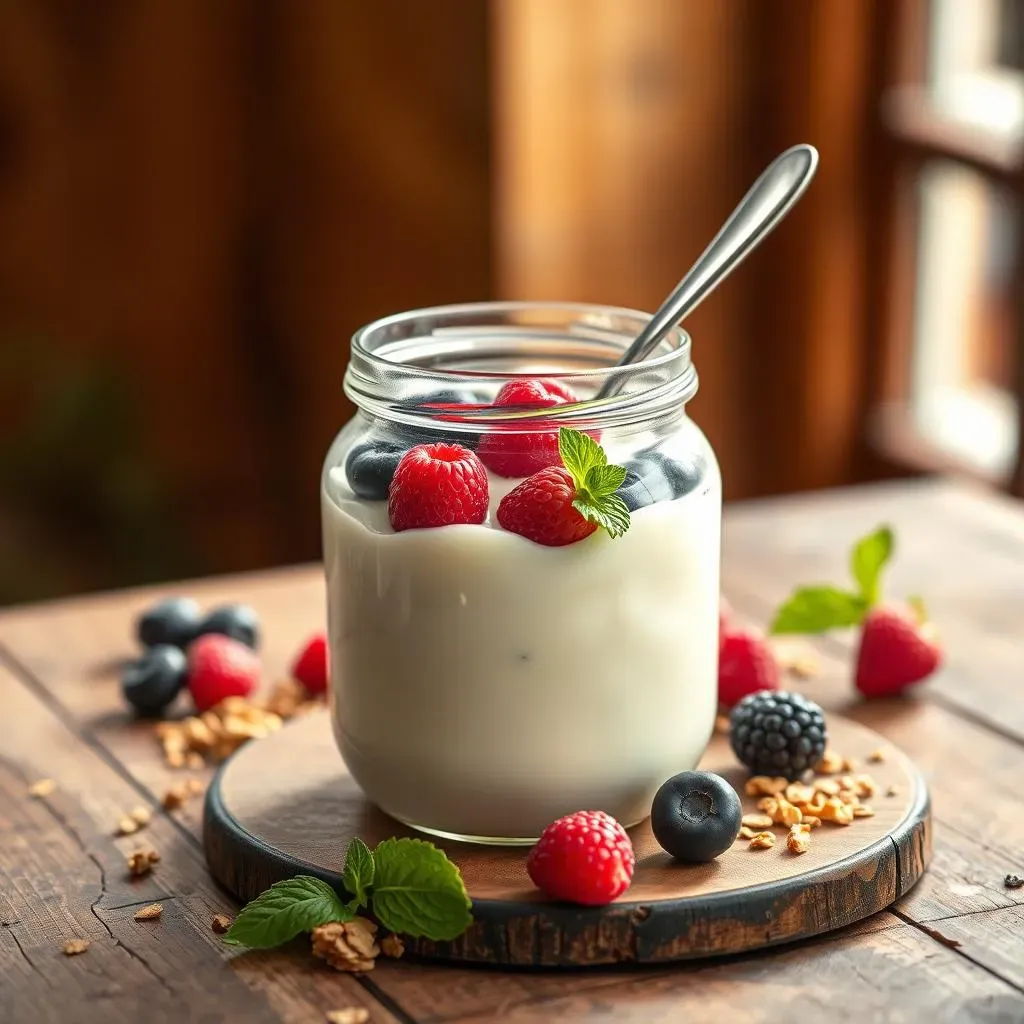Table of Contents
Are you on the hunt for the best low fat yogurt? Let's be honest, navigating the dairy aisle can feel like deciphering a secret code. With so many brands, flavors, and fat percentages vying for your attention, choosing the *best low fat yogurt* can be overwhelming. This article cuts through the confusion, guiding you on a delicious journey to find the perfect yogurt for your taste and health goals. We'll explore the nutritional aspects of low-fat yogurt, helping you understand what to look for on those nutrition labels. Then, we'll dive into a review of popular brands and types, comparing their pros and cons. Finally, we'll share creative and delicious ways to incorporate your newfound favorite low-fat yogurt into your daily diet. Get ready to discover a world of creamy, healthy possibilities! Prepare to become a low-fat yogurt connoisseur!
Choosing the Best Low Fat Yogurt for Your Health

Choosing the Best Low Fat Yogurt for Your Health
Understanding the Nutritional Landscape
So, you're diving into the world of low-fat yogurt – fantastic! But before you grab the first brightly colored container, let's talk nutrition. The key is to look beyond the marketing hype and focus on the facts. We're aiming for a yogurt that's low in fat, naturally, but also packs a punch in the protein department. Protein keeps you feeling full and satisfied, which is crucial if you're trying to manage your weight or simply maintain a healthy lifestyle. Also, keep an eye on the sugar content. Many yogurts are loaded with added sugars, which can negate the health benefits. Look for yogurts with minimal added sugar, ideally opting for plain varieties and adding your own fruit or sweeteners if desired. This gives you complete control over the sweetness level.
Remember, low-fat doesn't automatically mean healthy. Some low-fat yogurts compensate for the lack of fat by adding more sugar or artificial ingredients. This is where reading the nutrition label becomes your superpower! Pay close attention to the serving size, calories, total fat, saturated fat, sugar, and protein content. Compare different brands and options to find the one that best fits your needs and preferences. Don’t be shy about checking multiple brands. A little comparison shopping goes a long way.
Nutrient | Why it Matters | What to Look For |
|---|---|---|
Protein | Keeps you full, supports muscle growth | At least 10-12 grams per serving |
Sugar | Avoids blood sugar spikes, excess calories | Less than 10 grams per serving, ideally less |
Fat | Provides satiety, essential fatty acids (but in moderation) | Low in total fat and saturated fat |
Decoding Yogurt Labels: A Consumer's Guide
Let's face it; yogurt labels can be confusing. They're often filled with marketing jargon and tiny print, making it difficult to decipher what's actually in your yogurt. One of the most important things to look for is the "added sugar" content. Many yogurts, even those marketed as healthy, contain a surprising amount of added sugar. This added sugar doesn't contribute to nutritional value; it just adds extra calories and can negatively impact your health. Always opt for plain, unsweetened yogurts whenever possible, then add your own fresh fruit, a drizzle of honey, or a sprinkle of cinnamon to customize the flavor. This way you control the sweetness and avoid hidden sugars.
Another important factor to consider is the type of milk used. Some yogurts are made with whole milk, while others use skim or low-fat milk. Whole milk yogurts will naturally have more fat, but they can also be creamier and more satisfying. Low-fat options are a good choice if you're watching your calorie intake. Beyond fat content, consider the source of the milk – look for organic options if possible, and consider whether you prefer Greek yogurt (thicker, higher protein) or regular yogurt (thinner, slightly tangier).
- Check the "Added Sugars" amount
- Compare total fat and saturated fat
- Look for yogurts with high protein content
- Consider the type of milk (whole, skim, low-fat)
- Note the presence of probiotics (beneficial bacteria)
Navigating the World of Low Fat Yogurt: Brands and Types

Navigating the World of Low Fat Yogurt: Brands and Types
Exploring Popular Brands
Okay, so you've mastered the art of reading nutrition labels. Now let's talk brands! The world of low-fat yogurt is vast, with a seemingly endless array of options. Some popular choices include Chobani, Fage, Oikos, and Stonyfield. Each brand offers a range of flavors and styles, from plain and simple to fruit-infused and even chocolate-flavored varieties. But don't just go by brand recognition; remember to always check the nutrition facts. What might be a top pick for one person could be a sugar bomb for another. Consider your personal preferences – do you prefer Greek yogurt (thicker, tangier) or regular yogurt (smoother, sometimes sweeter)? Do you want plain yogurt to customize with your own toppings, or do you prefer pre-flavored options? The best brand for you will depend on your individual taste and dietary needs.
Beyond the big names, keep an eye out for smaller, local brands. These often offer unique flavors and higher-quality ingredients. You might discover a hidden gem that becomes your new go-to! Don't be afraid to experiment and try different brands to find the ones that you truly enjoy. After all, choosing a healthy yogurt shouldn't feel like a chore. It should be a delicious adventure.
Brand | Type | Notable Features |
|---|---|---|
Chobani | Greek & regular | Wide variety of flavors, often high in protein |
Fage | Greek | Thick, tangy, high protein |
Oikos | Greek | Often contains probiotics, various flavor options |
Stonyfield | Regular & organic | Focus on organic ingredients, many flavors |
Beyond the Basics: Exploring Different Yogurt Types
While Greek yogurt often takes center stage, the world of low-fat yogurt extends far beyond that. Consider Icelandic Skyr, known for its incredibly high protein content and thick, creamy texture. It's a fantastic option for those looking for a protein boost. Then there are options such as low-fat kefir, a fermented milk drink that's packed with probiotics, beneficial bacteria that support gut health. Kefir has a slightly tangier taste than most yogurts. Don't forget about plant-based yogurts! Soy yogurt, coconut yogurt, and almond yogurt are excellent alternatives for those who are dairy-free or lactose-intolerant. While they might not always match the protein content of dairy yogurts, they offer a delicious and healthy choice.
Remember, the "best" type of low-fat yogurt is subjective. It depends entirely on your individual preferences and dietary needs. Experiment with different types to find the ones you enjoy the most. Maybe you'll discover a new favorite that becomes a staple in your diet. The possibilities are endless – go forth and explore!
- Greek Yogurt: Thick, tangy, high protein
- Icelandic Skyr: Extremely high protein, thick
- Kefir: Fermented milk drink, high in probiotics
- Plant-Based Yogurts (soy, coconut, almond): Dairy-free options
Incorporating the Best Low Fat Yogurt into Your Diet

Incorporating the Best Low Fat Yogurt into Your Diet
Beyond Breakfast: Creative Ways to Enjoy Low-Fat Yogurt
Let's face it: eating yogurt for breakfast every day can get a little…monotonous. But the beauty of low-fat yogurt is its versatility! Think beyond the usual breakfast bowl. It's a fantastic base for smoothies, adding creaminess and a boost of protein. Blend it with your favorite fruits, vegetables, and a splash of liquid (milk, juice, or water). You can even add a scoop of protein powder for an extra muscle-building boost. For a quick and healthy lunch or snack, try a yogurt parfait: layers of yogurt, granola, and fresh berries. It’s satisfying, visually appealing, and incredibly easy to customize.
Don't underestimate the power of low-fat yogurt in savory dishes! It can be a fantastic substitute for sour cream or mayonnaise in dips, sauces, and dressings. Think creamy yogurt-based dips for vegetables or chips, or a tangy yogurt dressing for salads. The possibilities are endless! Get creative and experiment with different herbs, spices, and flavor combinations. You might just discover your new favorite recipe. You'll be surprised by how versatile low-fat yogurt can be.
Dish | Yogurt Usage | Flavor Suggestions |
|---|---|---|
Smoothie | Base, adds creaminess | Berry, tropical fruit, green |
Parfait | Layers with granola, fruit | Honey, nuts, seeds |
Dip | Replaces sour cream/mayo | Herbs, spices, roasted vegetables |
Salad Dressing | Creamy base | Vinegar, lemon juice, herbs |
Making Low-Fat Yogurt a Regular Part of Your Diet
Integrating low-fat yogurt into your daily routine doesn't have to be complicated. Start by replacing higher-calorie snacks with a cup of yogurt. It's a filling and nutritious alternative to chips, cookies, or candy. Keep a few containers in your fridge, ready for a quick and healthy snack whenever hunger strikes. You can also add yogurt to your lunch or dinner routine. It adds a creamy texture and a protein boost to soups, stews, or even as a topping for savory dishes. A little creativity goes a long way. The key is consistency.
Remember, the goal isn't to completely overhaul your diet overnight. Start small, gradually incorporating low-fat yogurt into your meals and snacks. Find ways to enjoy it that fit your lifestyle and preferences. Don't be afraid to experiment with different brands, flavors, and recipes. The more you explore, the more likely you are to find ways to make low-fat yogurt a delicious and regular part of your healthy eating habits. Soon you’ll wonder how you ever lived without it.
- Replace high-calorie snacks with yogurt
- Add yogurt to smoothies and parfaits
- Use yogurt in savory dishes (soups, stews, dips)
- Experiment with different flavors and recipes
- Make it a regular part of your meal plan
